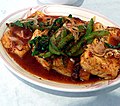Jjim
| Jjim | |
 Andong jjimdak, a variety of jjim dish | |
| Korean name | |
|---|---|
| Hangul | 찜 |
| Revised Romanization | jjim |
| McCune–Reischauer | tchim |
 |
| This article is part of a series on |
| Korean cuisine 한국 요리 조선 료리 |
|---|
Jjim (찜; Korean pronunciation: [tɕ͈im]) is a Korean cuisine term referring to dishes made by steaming or boiling[1] meat, chicken, fish, or shellfish which have been marinated in a sauce or soup. The cooking technique originally referred to dishes cooked in a siru (시루, earthenware steamer mainly used for making tteok) by steaming. However, the name jjim has now come to imply a finished dish with a steamed appearance. The cooking method for most jjim dishes nowadays has changed to boiling the ingredients in broth and reducing the liquid.[2] Pressure cookers are popular for making jjim as well.[3]
Proteins galbi, beef shank or rump, chicken, fish, or shellfish are usually the main ingredients. The ingredients are marinated in a sauce, then put to a boil with a small amount of water. The liquid is then reduced. Various vegetables and other ingredients are added for enhanced flavor.[2]
Varieties[]
- Galbijjim (갈비찜), made by steaming marinated galbi (beef short ribs) with diced potato and carrots in ganjang sauce.
- Andong jjimdak (찜닭), made by steaming chicken with vegetables and cellophane noodles in ganjang(간장, soy) sauce.
- Gyeranjjim (계란찜), made with eggs
- Saengseon jjim (생선찜), made with fish
- Agujjim (아구찜), made by steaming marinated blackmouth angler, stalked Sea Squirt, kongnamul (soybean sprouts), and minari (미나리, Oenanthe javanica). It is a local specialty of Masan, South Gyeongsang Province.
- Domijjim (도미찜), made with sea bream
- Eundaegujjim (은대구찜), made with cod
- Jeonbokjjim (전복찜), made with abalone marinated in a mixed sauce of ganjang (Korean soy sauce) and cheongju (rice wine)
- Dubujjim (두부찜), made with tofu
- Tteokbokki (떡볶이), made with tteok
Gallery[]

Agwi-jjim (blackmouth angler jjim)

Galbi-jjim (beef rib jjim)

Jogi-jjim (yellow croaker jjim)

Mugeun-ji-jjim (aged kimchi jjim)

Gyeran-jjim (egg jjim)

Dubu-jjim (tofu jjim)
See also[]
- Seon, steamed stuffed vegetable dish
- Jorim, braised dishes
- Bokkeum, stir-fried dishes
- Korean cuisine
- List of steamed foods
References[]
- ^ "The general kinds of Korea Food". Korea Tourism Organization. Retrieved 2013-04-04.
- ^ a b (in Korean) Jjim Archived 2011-06-10 at the Wayback Machine at Nate Encyclopedia
- ^ (in Korean) Lee, Yangji (이양지). Smart Healthy Meal (야무진 건강 밥상), Samseong Publishing, 2005. ISBN 89-15-04094-5
External links[]
| Wikimedia Commons has media related to Jjim. |
- Korean cuisine
- Steamed foods





